Day 35-37 – February 8-10
Huarmey, Peru to Pisco, Peru to Nazca Peru to Abancay, Peru
We drove from Huarmey to Pisco continuing through the desert on the PanAmerican Highway. This is a beautiful road surrounded by huge skylines and dunes – but not particularly interesting. The road is straight with few curves and we were able to cover a lot of ground at high speeds.
Occasionally we were thrilled by a view of the Pacific which would appear slowly through the haze . . .
The dunes provided interesting textures and shadows . . .
Along the road we still encountered trash . . .
We decided to bypass Lima, Roger and Vince had been there previously and it’s a dirty and crowded city. But as we passed through the outskirts it was most interesting to see some pretty racy billboards – here’s a naked boy advertising Sprite with the bottle discretely covering his private parts. . .
There were some other more gamey ones – which Vincent got snaps of, but I was not quick enough to get the shots.
We stopped at a resort beach for lunch . . .
Later that day I tried to change a hundred dollar bill at a bank but they wouldn’t take it because it had a suspicious serial number. At the same time I tried to withdraw money from an ATM but neither of my credit cards worked – fortunately I can borrow money from my friends.
We noticed a significant difference between the way an Indian from Ecuador or Peru would want to look and the Mestizo (European-Indian descent) of Colombian. The Colombian woman strive to have large derrières tightly packaged in blue jeans like this . . .
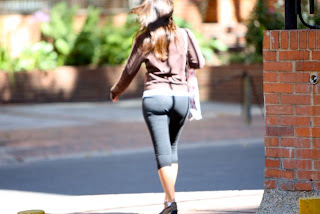
. . .whereas the Indians in Ecuador and Peru like thicker mid sections with a slight role (or love handle). Both of these traits have survival value that in prehistoric times would be viewed as favorable qualities to a mate since they would assist in surviving through difficult times. The Turks favor Rubenesque women – a shape that also has survival value. However the Americans, and some Europeans, in the very recent past have favored the anorexic look – some models in magazines such as Vogue go as far as adding thick eye shadow to give a cadaverous Charles Adams look. We now seem to be shifting to a preference for the athletic look with toned muscles; but to us even a small amount of fat is definitely out.
I am pondering as to how the American ideal got so far away from the ideal in other cultures and frankly the ideal that would indicate good health. I want to include the disclaimer that I am not favoring a fat obese look that we struggle with in the mid west (other countries struggle with the same problem). There are a lot of short overweight Indian women here in Peru as well; but it does make one wonder.
We spent the evening in Pisco at an incredibly nice hotel; but it was incredibly dusty and sandy. There is a haze in the air and the wind blows the dust and Pacific sand everywhere. Helge is pondering where to spend the night with the group next year and I’m sure he will come up with a winner.
One of the nice points about the dunes are the dune buggy rides – check out this monster dune buggy. . .
We looked for other hotels and had breakfast at a fancy one nearby . . .
We thought it was a little too fancy so we checked out another hotel and it was even fancier. The hotel selection is a work in process.
We headed out of Pisco and drove a short 3-hour distance to Nazca. Nazca is famous for its large scale pictures created by the Incas. Some made by digging trenches and placing stones are nearly a mile in length and can’t really be appreciated from the ground. Some of the lines are thought to have meaning as an agricultural calendar. Later on the others took the airplane tour to get a better view.
We visited the museum that features the lines of Nazca and learned about Maria Reiche who discovered, interpreted and helped preserve the images and lines. Although it was very interesting, I think the Incas had accomplishments which far outweigh these lines. I interpret the lines as comparable to the French cave paintings. The Incas established complicated irrigation systems for agriculture, detailed and precise calendar systems, monumental construction and superbly interesting graphics.
I left ahead of the others after stopping for a break, got too far ahead and got lost.
It was a bit embarrassing – my cell phone wasn’t charged, I had no money and my debit cards weren’t working (and couldn’t speak the language). This was not too worrisome – I had a half tank of gas and my mother always said I’m charming. Luckily I met up with the guys again 50 miles down the road – they had taken another path.
We drove into the Atacama Desert to visit an Incan cemetery. The Spaniards, needing funds for their military exploits in Europe, would dig up Indian graves which often contained silver. They would leave the skeletons on the desert, which in turn were preserved by the dryness. Twenty years ago when Helge visited this area the skeletons were still strewn on the ground. On our visit the remaining bones on the desert were few – such as this large femur . . .
They have since organized the remains into pits throughout the site.
Some of the Indian women we see along the road have very long braids but nothing compared to these mummies . . .
The braid on this corpse is perhaps 6 feet long . . .
The desert naturally mummifies the corpses – this foot (probably 500 years old) still has the skin on it . . .
We returned to Nazca and spent the night in a hotel.
We left Nazca with the intention of climbing through the mountains as far as Abancay, a stepping stone to Cuzco.

We headed out of the desert after spending 5 days on the straight road in the dust and heat. It was a relief to head up into the mountains even though the desert often rewarded us with the lovely sight of beaches on the Pacific.
We climbed over a number of passes from 13,000 feet up to 15,000 feet passing through layers of fog and mist. There was a considerable amount of farming and grazing above 13,000 feet.
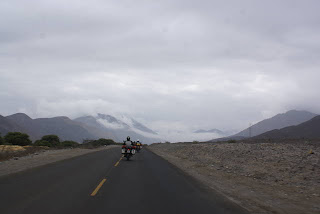
We were held up by road construction along the way.
The delays consumed more than an hour and forced us to ride on rather unstable gravel with the shoulder of the road looming more than 1,000 feet below.
While waiting, Helge shows an eager group of young Peruvians the mechanics of his new Zumo GPS. They were handsome young men with curiosity and a well-developed sense of humor.
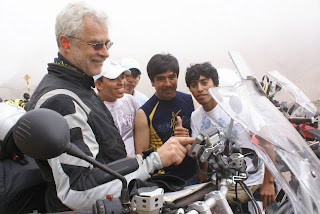
The road is clearly difficult to build and equally as difficult to maintain. The rock cliffs are unstable and you could pull them out of the face with your hand. Here a front end loader is traversing the road and removing falling rocks.

This is a lot of work for a road that might see 4 cars an hour – other than those related to the construction.
Vincent stretches out for a nap while waiting for the road to open.

As we crossed to the other side of the mountain range we begin to see green and with it animals – both off and on the road. This one being an alpaca or perhaps a vicuna. . .
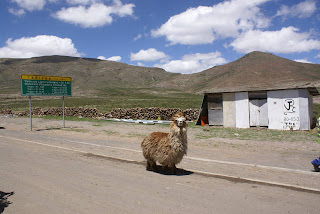
Even though we are above 13,000 feet the green is ever present. I would love to know the physics behind the moisture from the Pacific dumping on the eastern side of the range rather than the western.
The western side of the range is a desert which runs the length of Peru and into Chile and the eastern side is lush grazing land packed with animals wondering on and off the road.

In this beautiful mountain area Peru has redeemed itself as there is no longer the trash and debris alongside the road.
We pass through some towns packed with colorful Indian apparel.

We meet this nice lady who has four children. Three of the children are walking with her and the forth, unbeknownst to us, is in a pouch on her back.

The child in the pouch begins to cry and with one svelte motion she swings the pouch around to her front and begins nursing the baby.

I saw another interesting maneuver by an Indian woman – she was squatting by the side of the road as though resting wearing a full colorful skirt; but I noticed she was relieving herself – without the slightest hint of embarrassment.
As we approach 15,000 feet the weather begins to look iffy and we see the clouds release snow and rain.
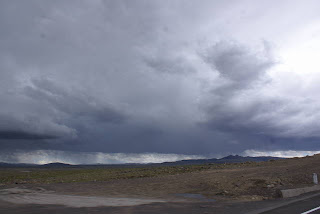
As we crest the top we see snow on the mountain and begin to get a light snow shower. In addition to the snow there is gravel on the corners – we are slow, methodical and careful.

Riding down the other side we see the road looping through the valley as it sheds 3,000 feet of altitude.

We pass through some gorges . . .
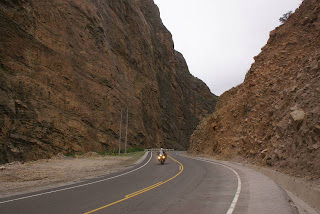
We fall about 2 hours short of making it to Abancay and end up spending the night at a beautiful motel-chalet arrangement developed by an Italian married to a Peruvian lady.
Vince and Roger catch fish for our dinner in a pond and the chef prepares it magnificently.
We have no Internet or cell phone service so I have every intention of retiring by 9:00 p.m.
Back to Top

Add A Comment